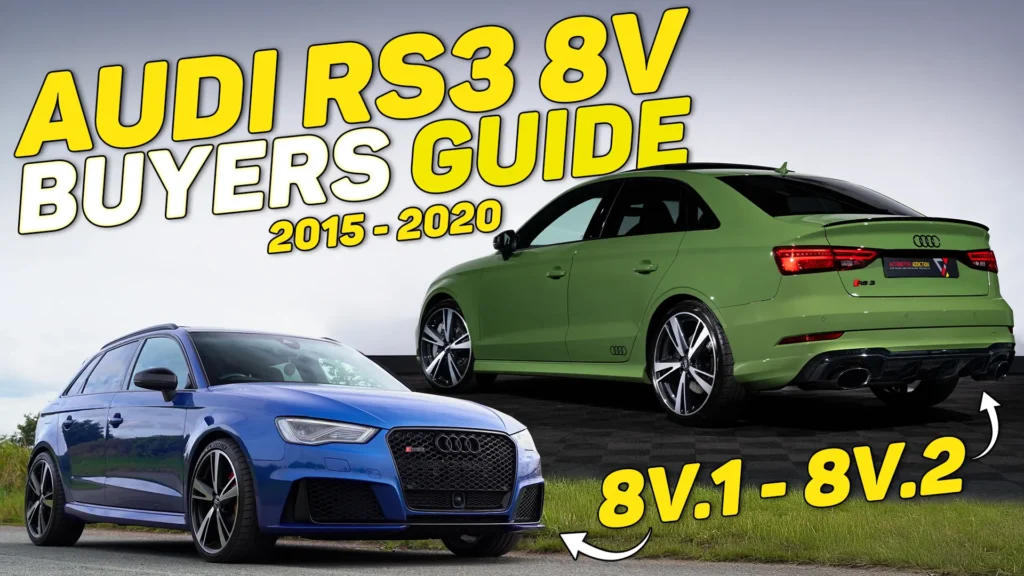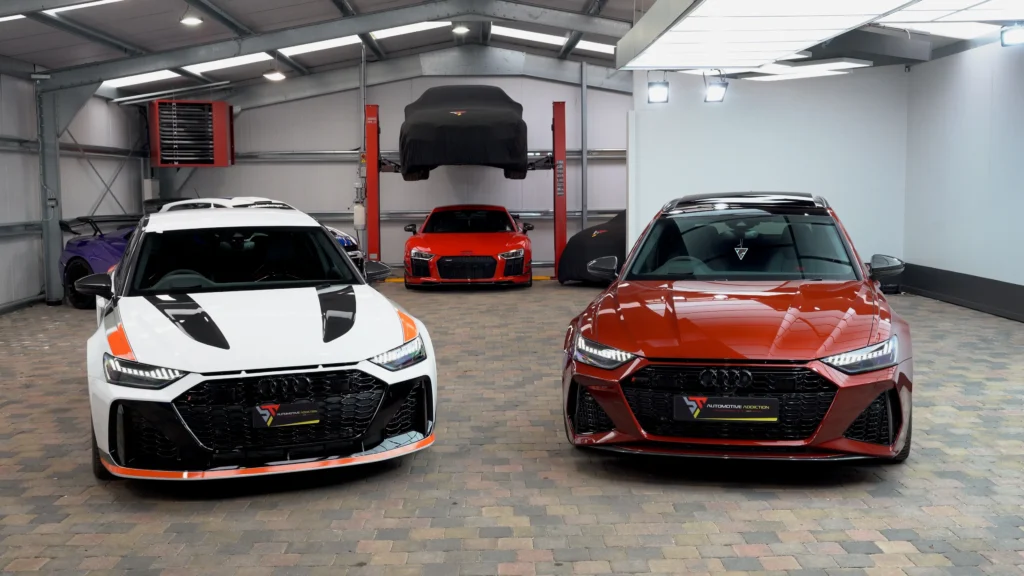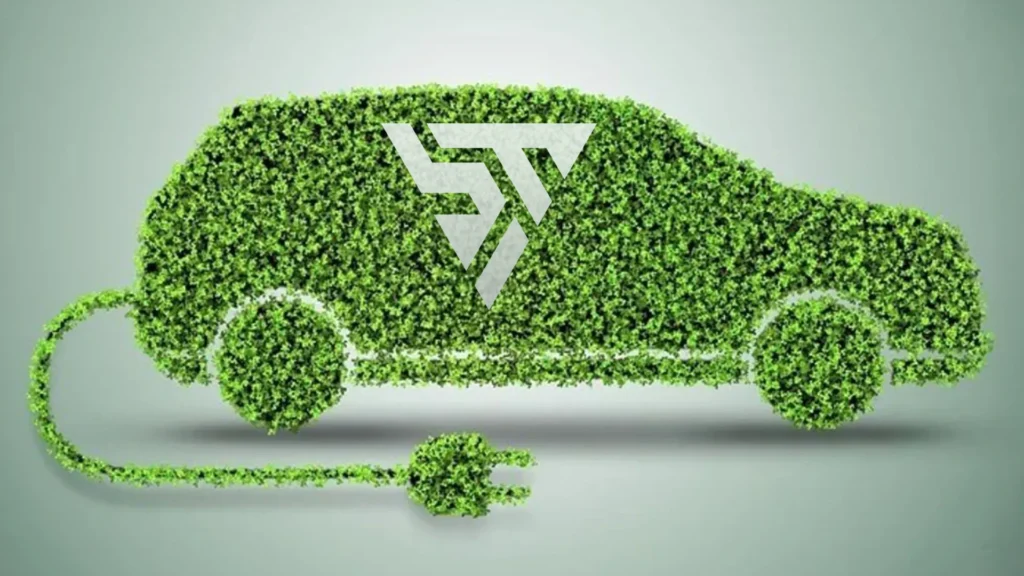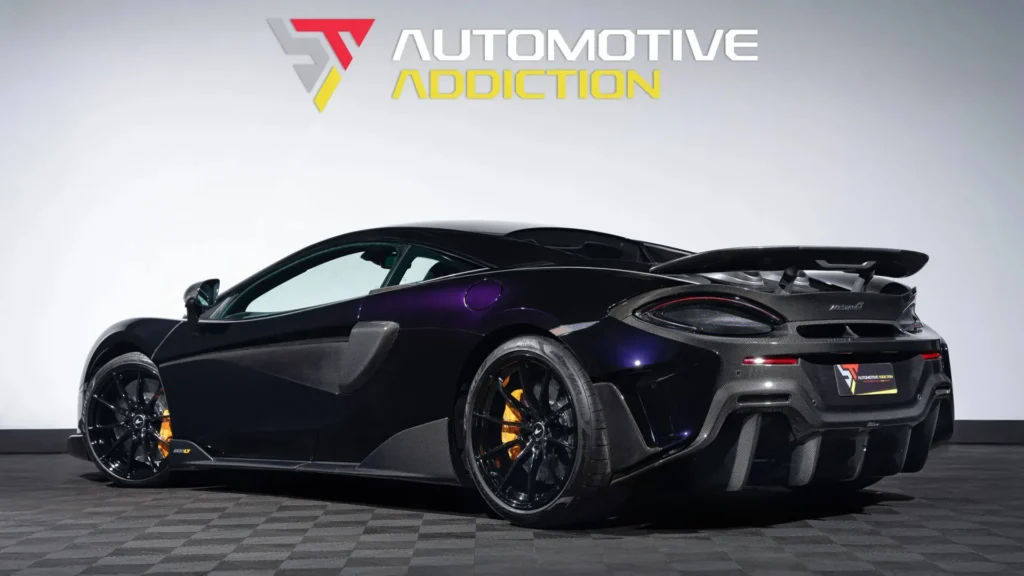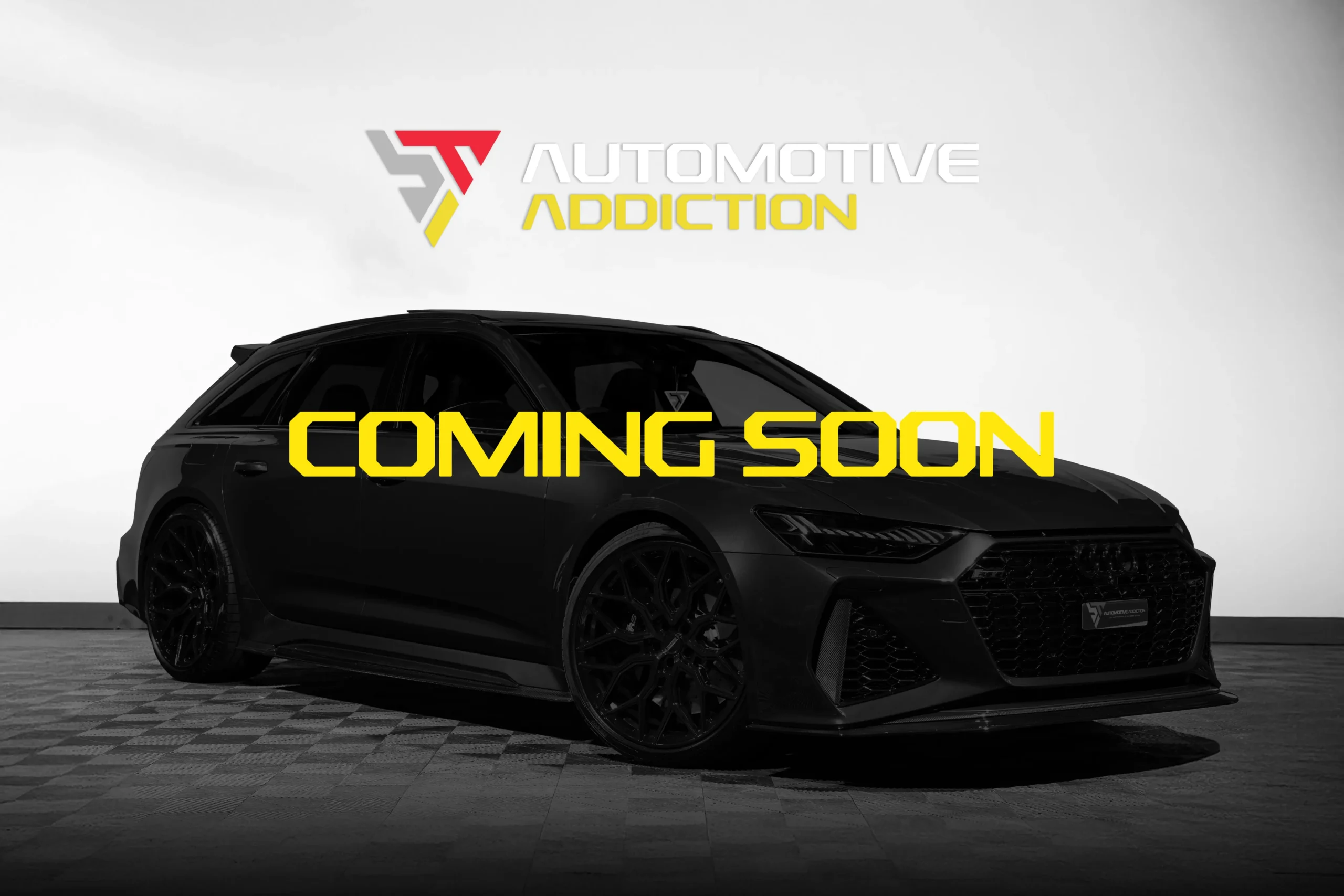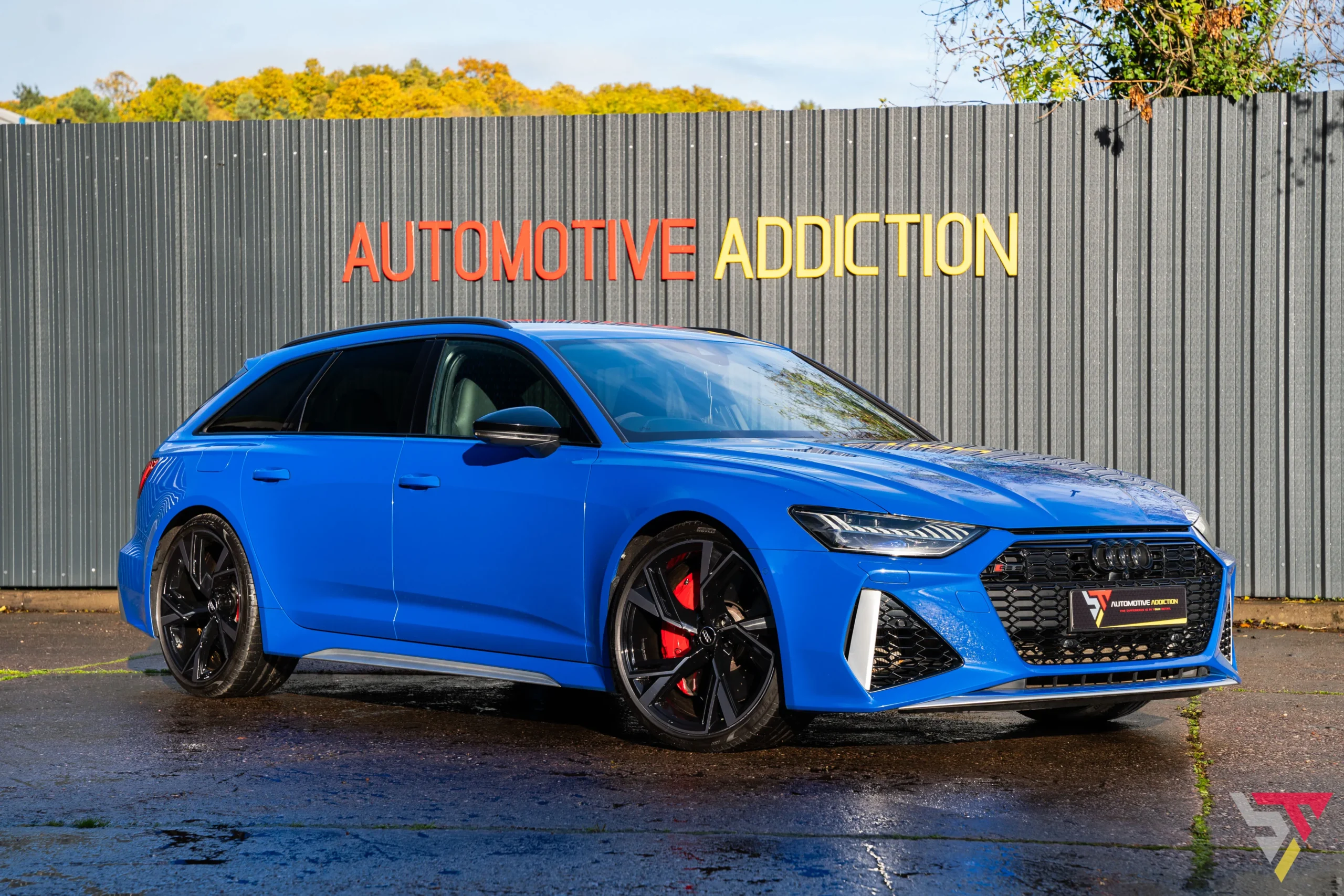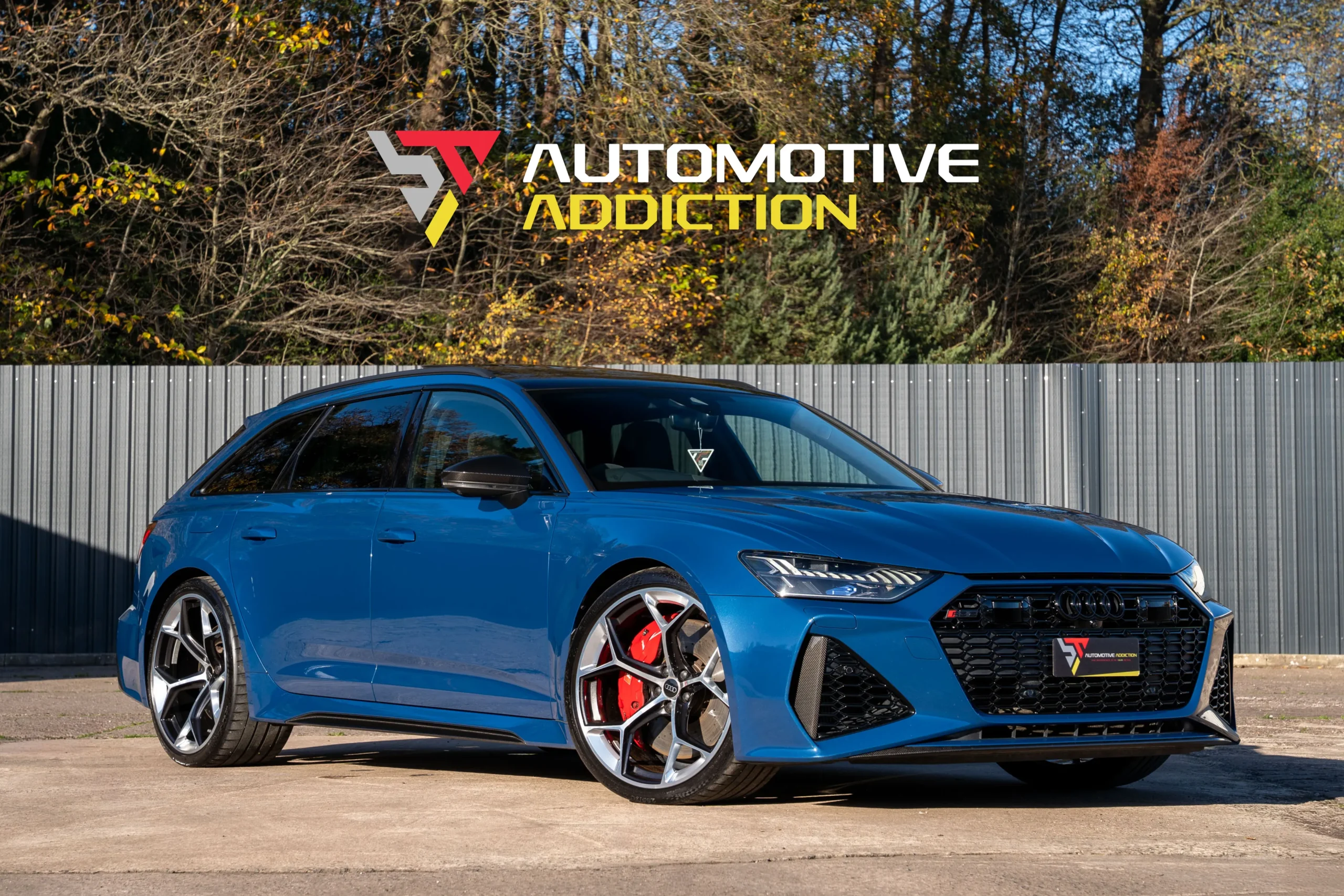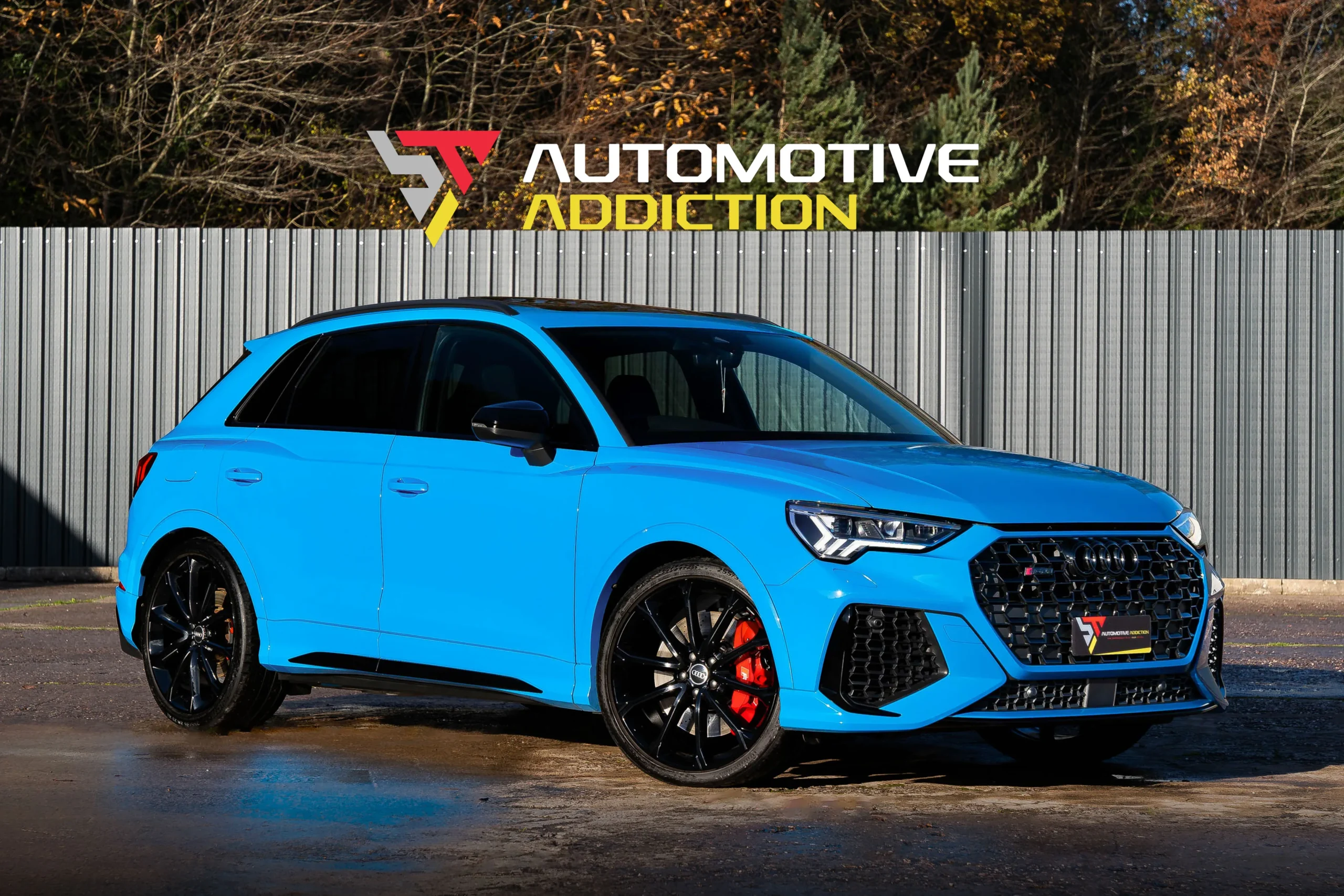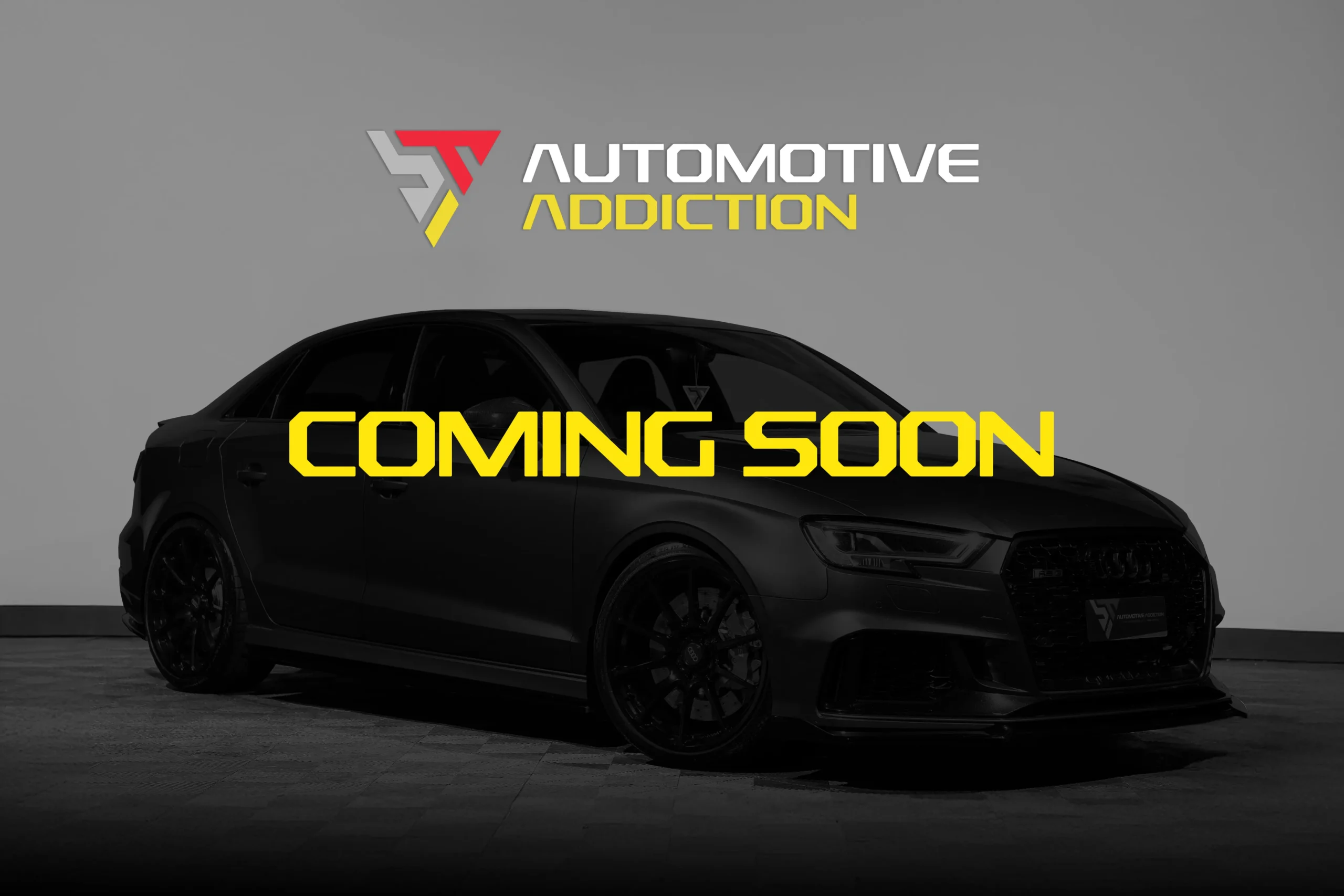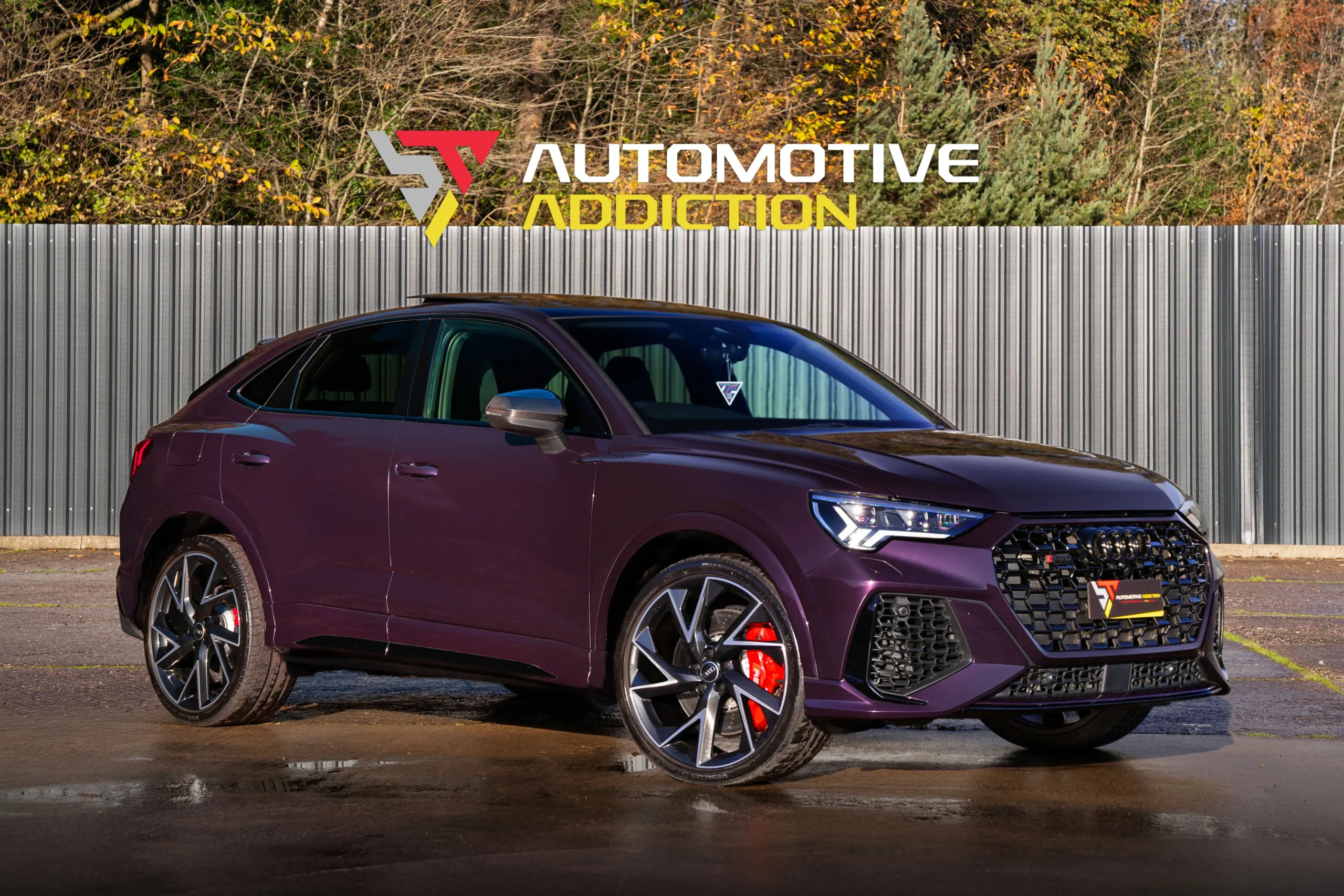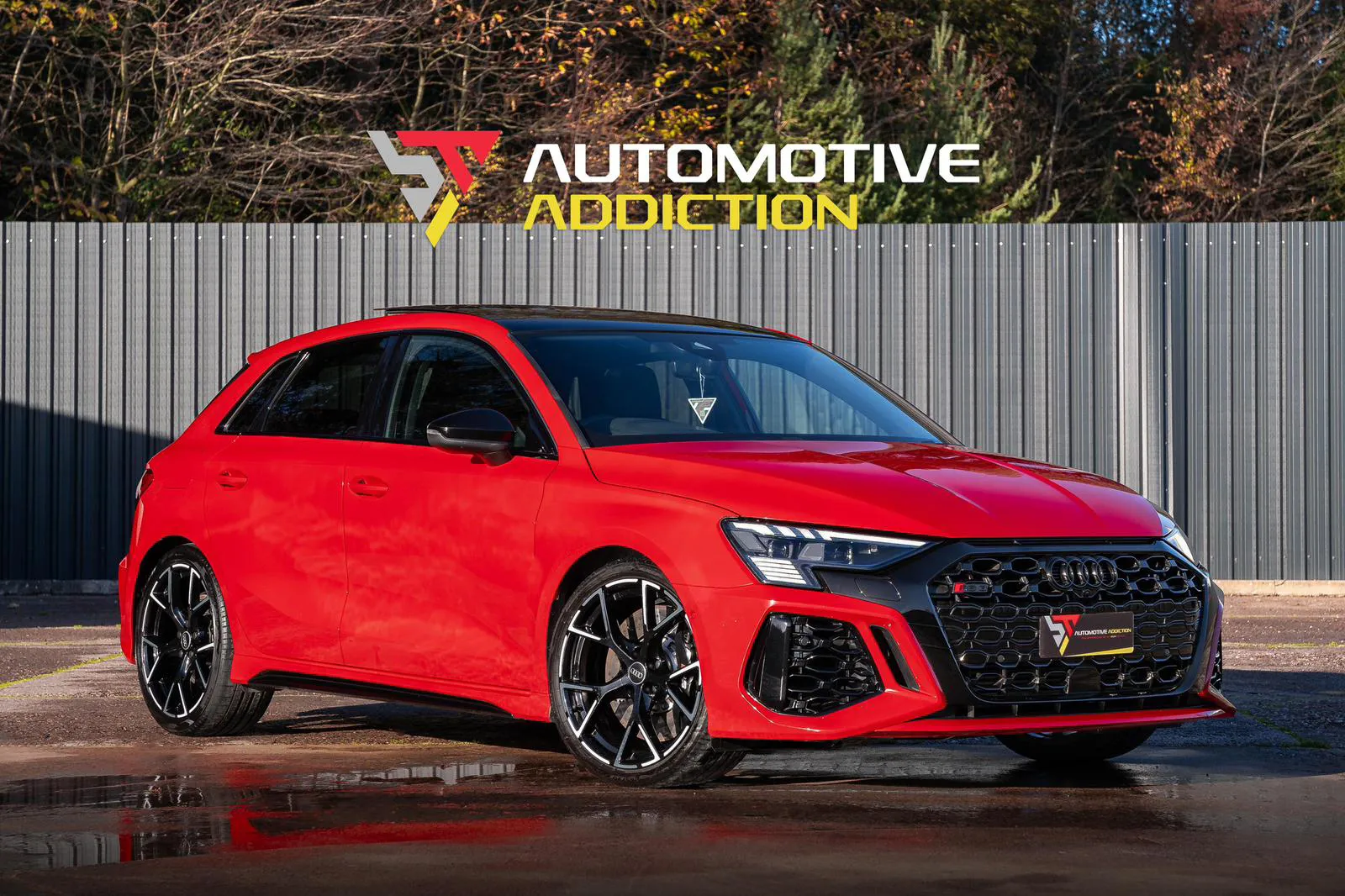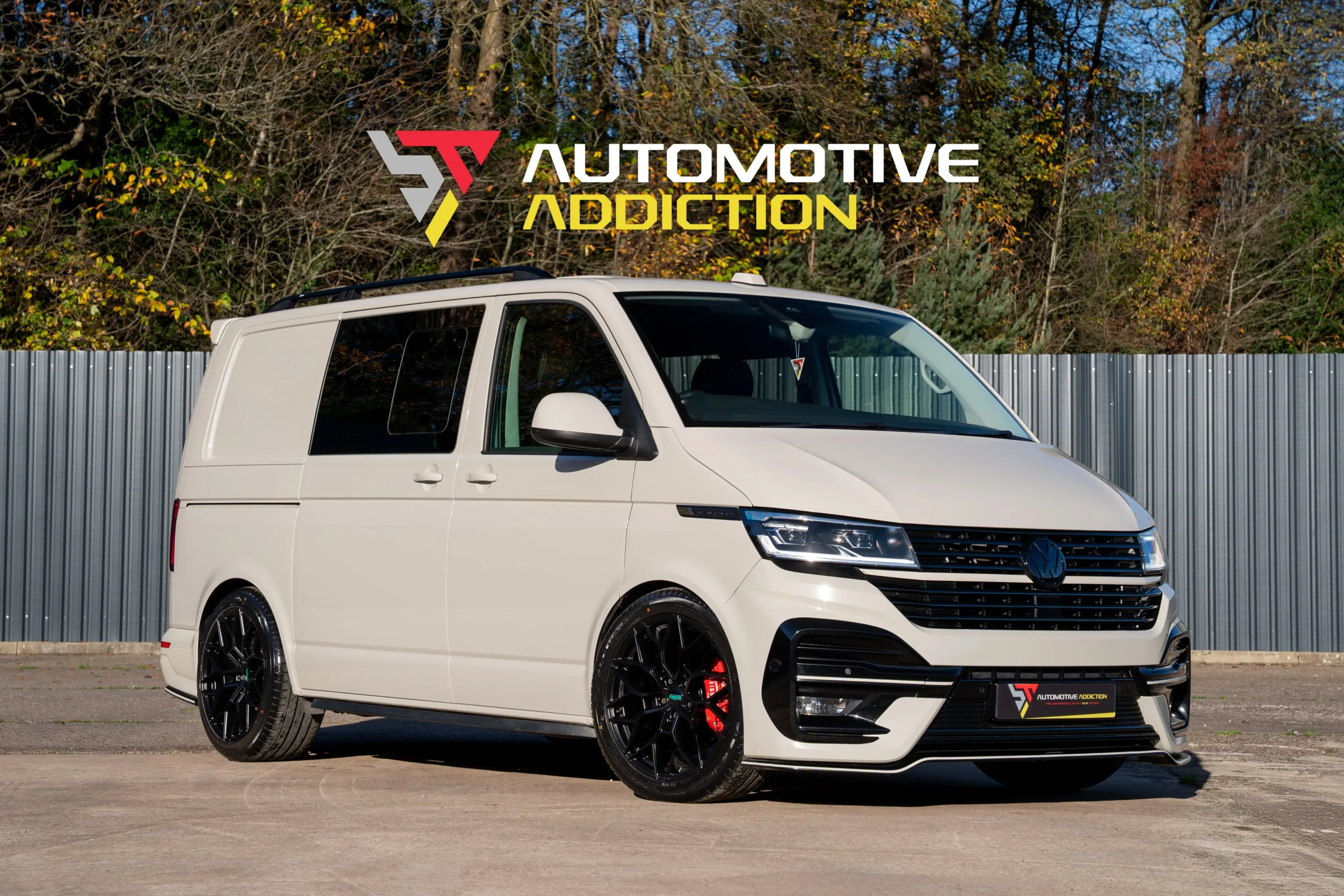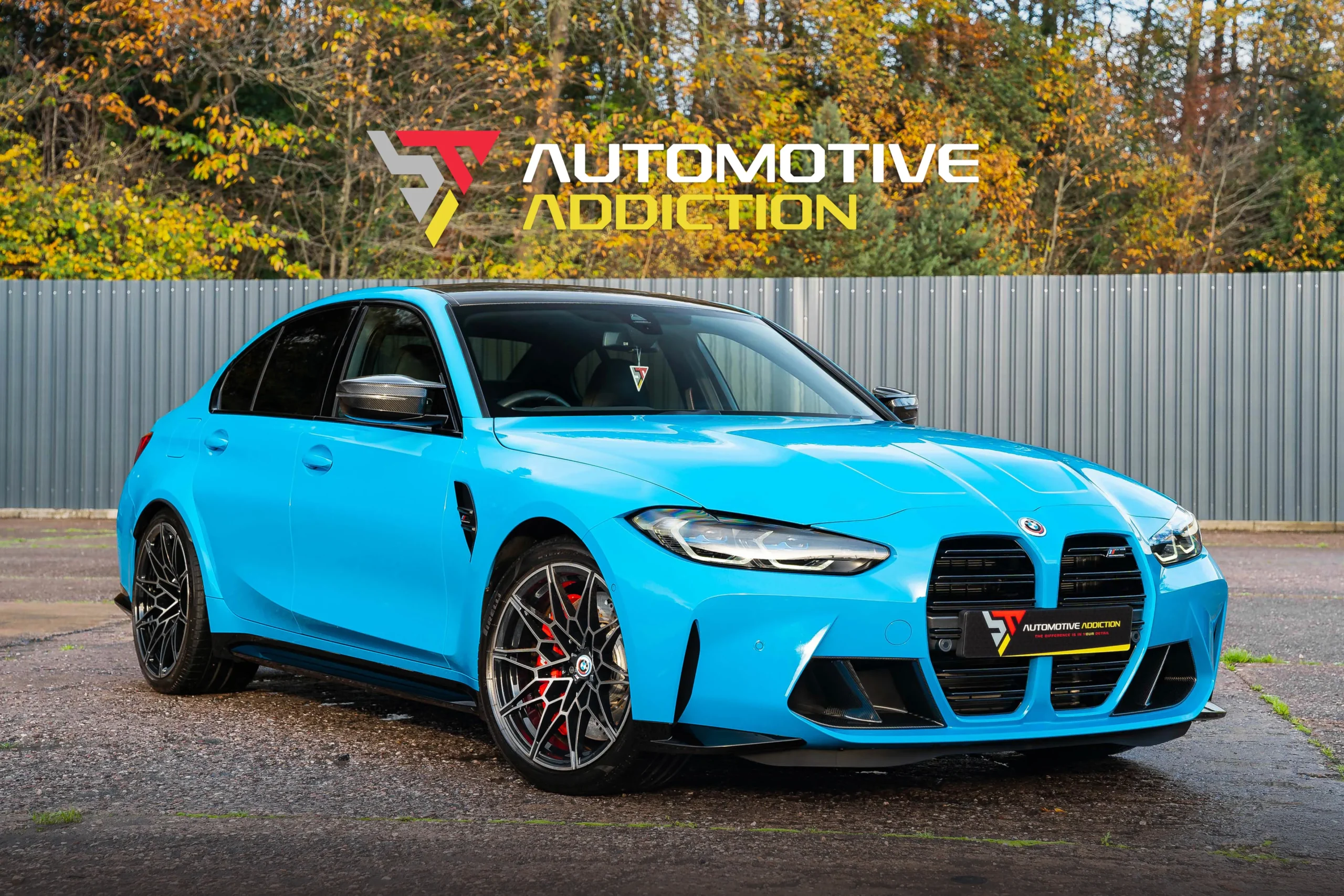For many enthusiasts, the Audi RS3 represents the ultimate everyday performance car: compact, understated, devastatingly quick, and blessed with that unmistakable five-cylinder soundtrack. This Audi RS3 Buyers Guide will help you navigate the four main versions on the market – the original 8V, the facelifted 8V.2 with its legendary DAZA engine, the later OPF-equipped variant, and today’s 8Y – buyers face a difficult decision. Which one offers the best balance of performance, sound, and tunability? And which makes the best base for future upgrades?
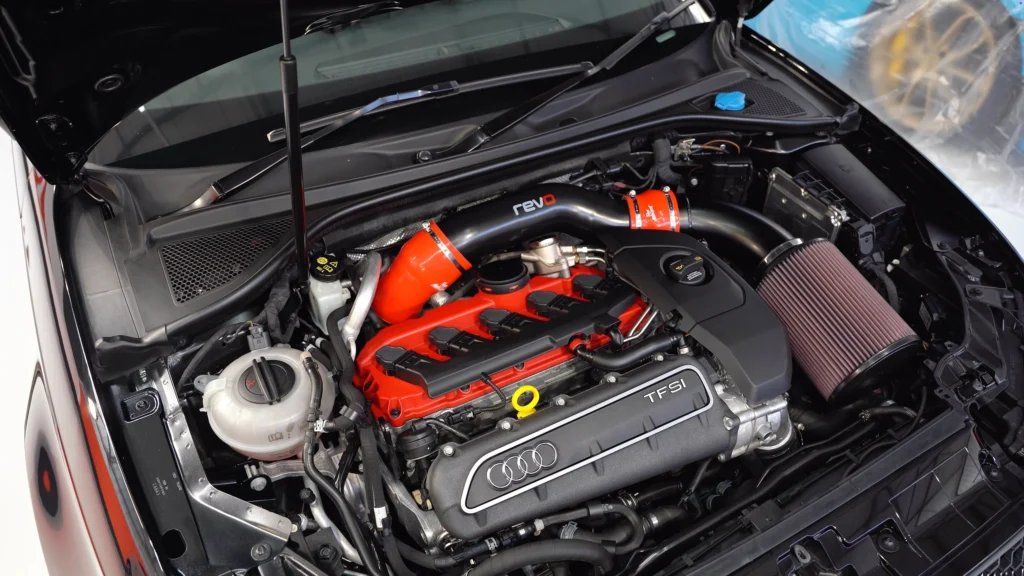
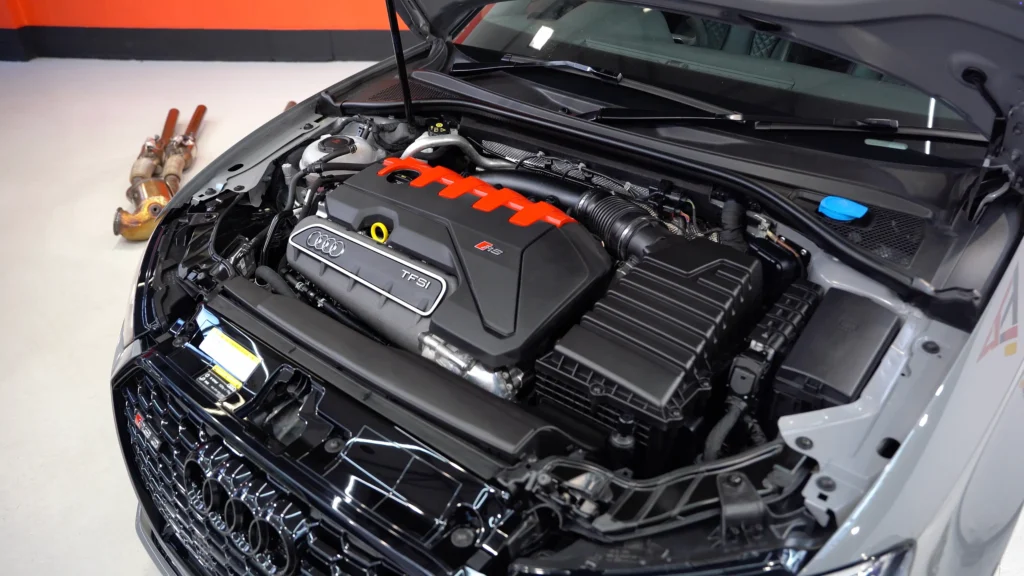
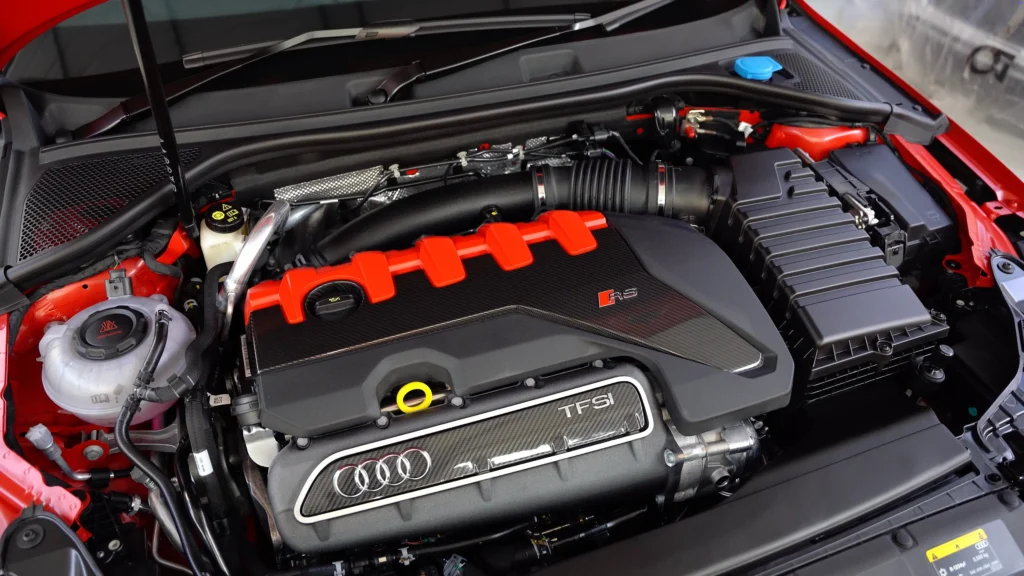
As one of the country’s principal Audi RS specialists, as well being expert moderators on the Audi RS Owners Club forum, the Audi RS3 8Y page and Audi RS6GT owners club page, Automotive Addiction has unrivalled experience with all generations of the RS3 platform, having sold over 700 examples to date, this makes us ideally positioned to guide you through this complex process, providing a dive deep into the details of each variant – including engines, exhaust note, tuning potential, styling, driving dynamics, and common issues – so you can pick the right RS3 for your garage.
Watch our video highlighting the differences between the models:
The Pre-Facelift 8V (2015–2016): The First of the Breed (CZGB vs DAZA vs DNWA Engine Comparison)
The story begins with the 8V RS3, launched in 2015. This was the car that got everyone excited about the RS3 in the first place. Under its bonnet sat the EA855 five-cylinder turbo (engine code CZGB), putting out around 367PS. This early engine was built around a super strong iron block, a smaller turbocharger and direct injection only, giving it a muscular low-range punch and that classic off-beat five-cylinder warble, that is vocally the loudest of the bunch.
On the road, it was brutally effective, combined with the DQ500 seven-speed gearbox and Haldex four wheel drive system – which powers the front wheels in most conditions, only shifting torque to the rear when the driving or conditions deem it necessary – sub-4.5 second 0–62mph times were easy with launch control, but compared with later models, the nose felt heavy and the power delivery a touch lazier. Tuners could extract solid gains, but the older, smaller turbo and fueling setup meant the ceiling wasn’t as high as what would follow.
That said, the 8V remains the most affordable way into RS3 ownership. If you’re willing to budget for upgrades like an uprated intercooler, intake cleaning (thanks to DI-only carbon build-up on the valves), and regular gearbox and differential servicing (bearings can get noisy) it’s a dependable entry point.
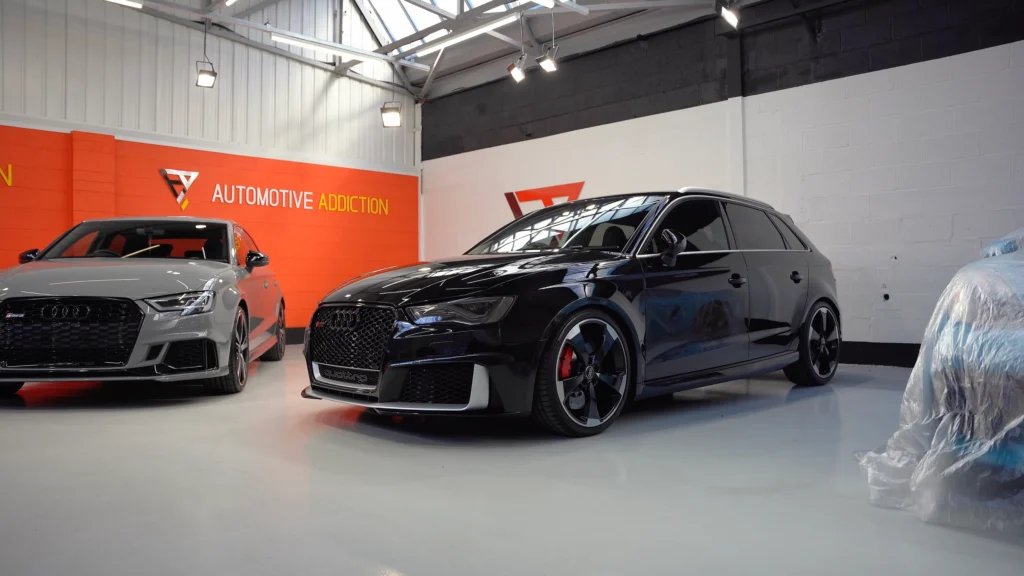

The Facelift 8V.2 (2017–2018): Enter the DAZA (CZGB vs DAZA vs DNWA Engine Comparison)
The real game-changer arrived in 2017 with the facelifted RS3, known internally as the 8V.2. The new DAZA engine transformed the car. Audi ditched the iron block for an aluminium one, shaving around 26kg off the front end. It added dual injection (direct and port – an upgrade designed to reduce carbon build-up on valves), an integrated exhaust manifold, and a new electronic wastegate, making the engine both lighter and far more efficient.

The swap to a larger turbocharger meant power jumped to 400PS, but more importantly, torque came in earlier and harder, and the engine was more responsive everywhere in the rev range. This combination of more power, less weight and a reconfigured Mechatronix software for the Haldex system (which directs more power to the rear) made the 8V.2 feel like a completely different car—sharper, more agile, with improved steering and with a more charismatic exhaust note, especially when paired with the optional RS Sports Exhaust.
For tuners, the DAZA is a dream. A simple Stage 1 map with supporting hardware can push power comfortably past 460–500bhp. Hybrid turbos take it into the 600–700bhp range, and with forged builds and upgraded fueling, 1,000bhp RS3s are now a reality. Add to this its improved reliability and reduced valve carbon build-up (thanks to port injection), and it’s easy to see why the DAZA-equipped RS3 has become the holy grail among buyers.
This extra performance potential comes free from added issues with the DAZA only really suffering from the same common problems as the iron-block cars, namely sticking injectors and noisy transfer box and differential bearings.
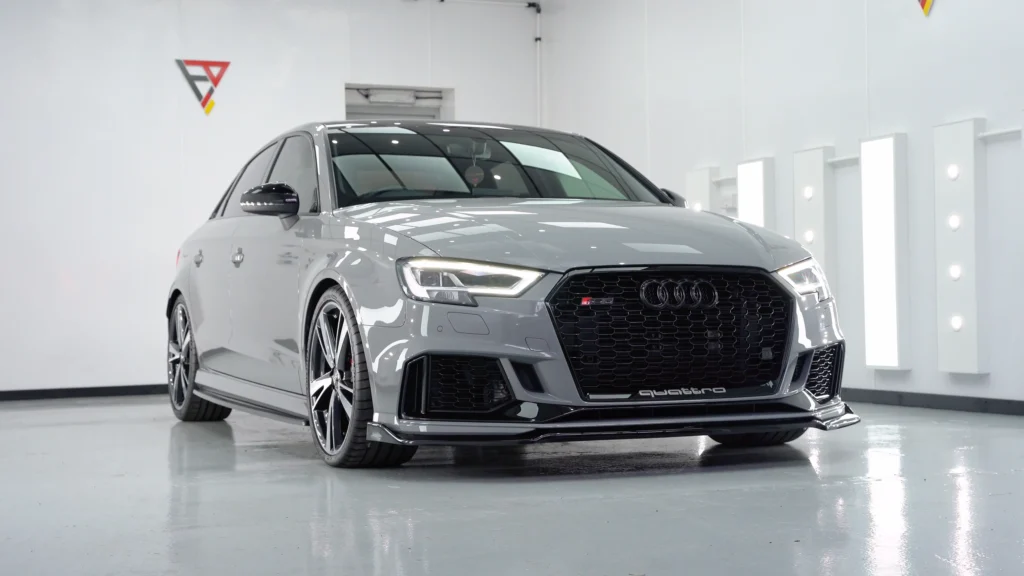
The OPF Era (2019–2020): DNWA and the GPF Effect (CZGB vs DAZA vs DNWA Engine Comparison)
In 2019, stricter emissions rules forced Audi to add a gasoline particulate filter (GPF/OPF) to the RS3. These late facelift cars, often coded DNWA, look almost identical to the DAZA but come with a more muted exhaust and slightly different ECU calibration to meet WLTP standards.
On paper, power remained at 400PS, and performance was unchanged. But to the ears of many enthusiasts, these OPF cars lacked the drama of their pre-filtered siblings. The crackles and pops were dialled back, the idle quieter, and the five-cylinder howl less raw.
That said, these cars are no less capable. With careful tuning, they can still match DAZA levels of performance—but the exhaust system becomes more complex to modify legally, and OPF deletes can lead to MOT headaches in the UK. For those wanting a stealthier, newer RS3 with the same mechanical strength, the OPF cars make a lot of sense – especially the fully-loaded Sport Edition cars – though they’ll always sit in the DAZA’s shadow for sound and tuner-friendliness, meaning prices for equivalent cars can be slightly lower than DAZA examples, even if the DNWA is slightly newer.
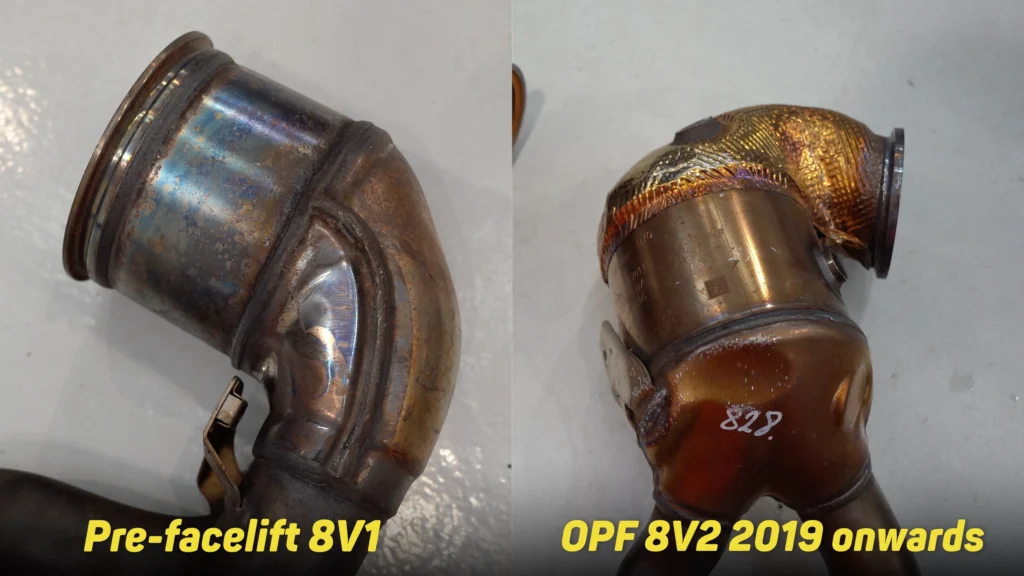
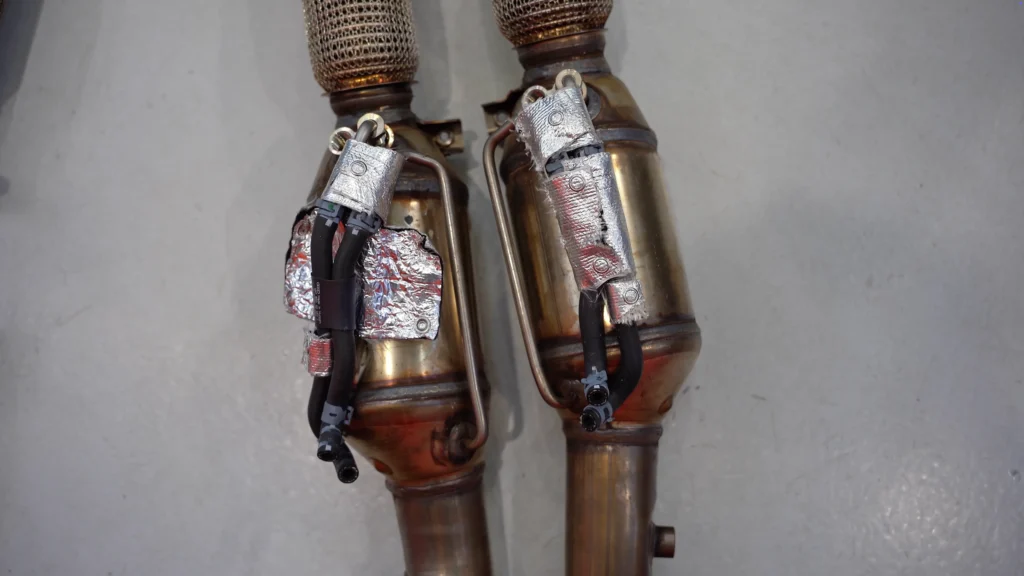
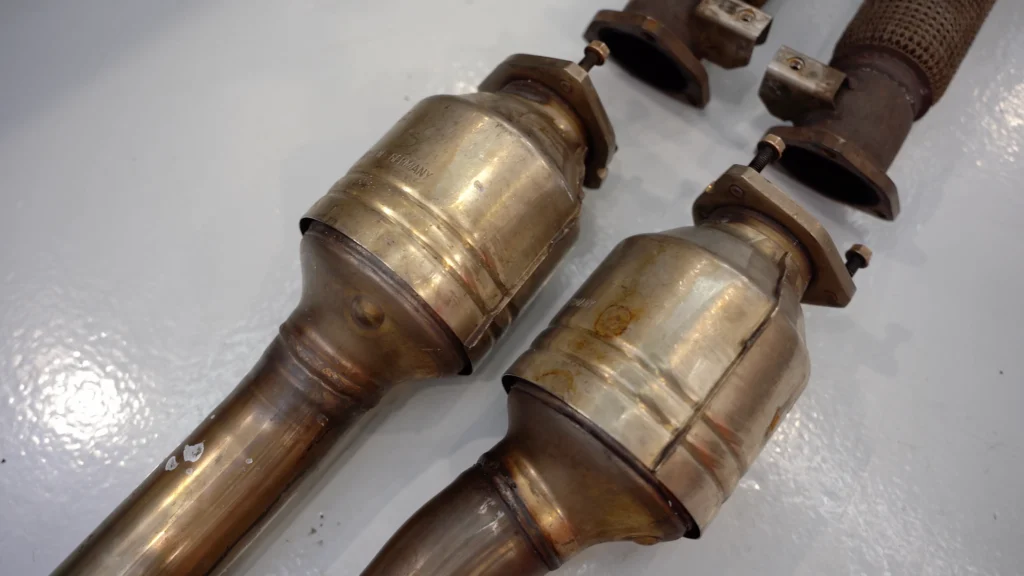
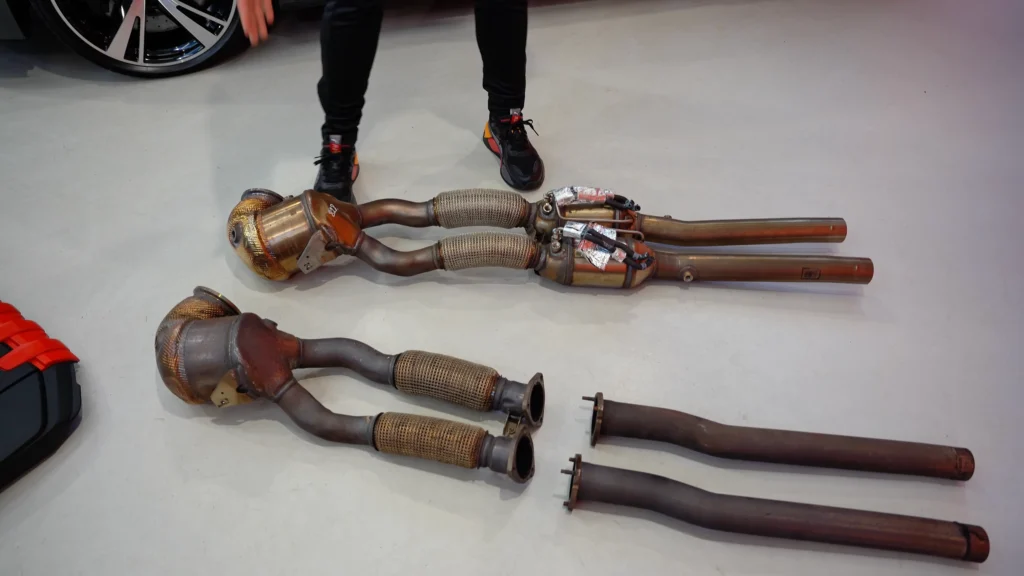

The 8Y DNWC (2021–present): The RS3 Grows Up (CZGB vs DAZA vs DNWA Engine Comparison)
The latest chapter in the RS3 story is the 8Y, launched in 2021. Still powered by the EA855 evo five-cylinder (DNWC engine code) as the DNWA, it makes 400–407PS depending on market. On paper, the figures don’t seem a big leap over the outgoing car, but in reality, the 8Y feels like a revolution.
The big news is chassis tech. Audi fitted the RS Torque Splitter, a twin-clutch rear axle system that can actively distribute torque side-to-side. This transforms the RS3’s character: instead of the Haldex-led “safe understeer” of old, the 8Y can now rotate under power, feel rear-biased in corners, and even slide when provoked. It’s the most engaging, confidence-inspiring RS3 to date, finally giving the chassis the adjustability its engine always deserved.
Of course, the 8Y comes with its own challenges. Like the OPF 8V, it has a particulate filter, and its newer MG1 ECU makes tuning more complex and costly. But once unlocked, Stage 1 tunes bring huge gains, and the improved chassis means the car can deploy every horsepower far better than its predecessors.
Inside, the 8Y is a leap forward too. A wide touchscreen replaces the old MMI, the digital cockpit is sharper, and RS-specific displays highlight torque-splitter behaviour, G-forces, and temps. Styling is more aggressive than ever, with a wide stance and functional aero touches, making it look every bit the modern super-hatch.


Exhaust Character: The RS3’s Soul
- One of the biggest talking points with every RS3 is the exhaust note.
- The 8V pre-facelift set the tone: raw, mechanical, with that distinctive five-pot burble.
- The DAZA facelift perfected it: loud, rich, and full of overrun theatrics that defined the RS3 experience.
- The OPF cars dampened it, keeping the five-cylinder character but stripping back the drama.
- The 8Y is the most muted stock, thanks to stricter drive-by noise limits. The five-pot song is still there, but aftermarket exhausts that retain the OPF are often needed to restore excitement.
- If sound is a priority, the DAZA stands clear as the best of the breed.
Common Issues: What Buyers Should Watch For
While the RS3 is generally robust, there are key checks to make:
- Haldex service (8V): Pumps clog if fluid changes are skipped.
- Gearbox (DQ500): Strong, but must be serviced on schedule.
- Ignition coils/plugs: Misfires under load usually trace back here.
- Cooling system: Older water pumps and thermostats can leak; check for replacements.
- Valve coking (pre-FL): Direct injection builds deposits—budget for walnut blasting.
- Engine mounts: Torque-heavy tuned cars often chew through them.
8Y-specific: Ensure torque-splitter fluid services are done and that ADAS sensors (radar, lane assist) are properly calibrated after any knocks.
Styling & Cabin: Spotting the Generations
Visually, each generation reflects its era. The 8V pre-facelift was clean and understated, with simple DRLs and a traditional Audi interior. The facelift 8V.2 added sharper bumpers and the all-important Virtual Cockpit. The OPF cars were identical outside, with changes hidden under the floor. The 8Y, though, is unmistakable—wide, aggressive, with a modern digital cabin and big-screen infotainment.
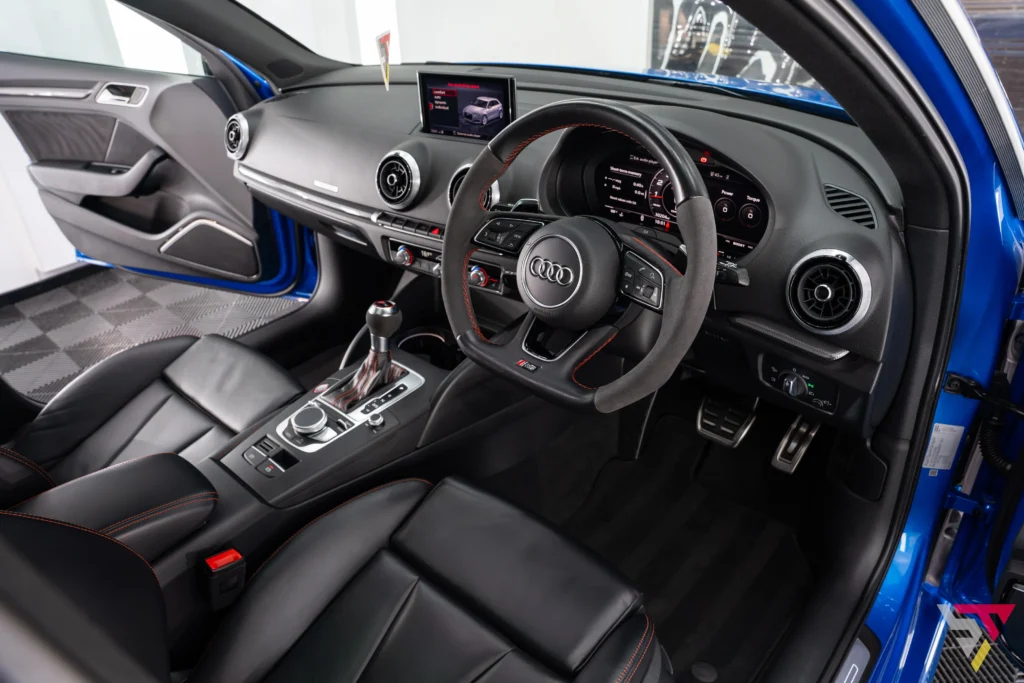
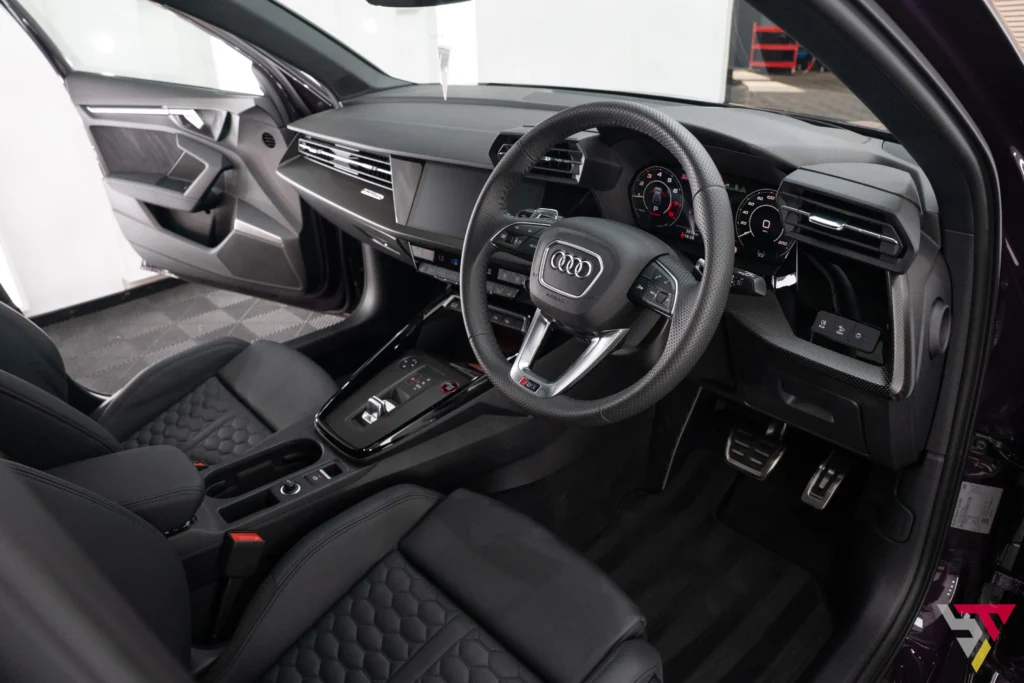
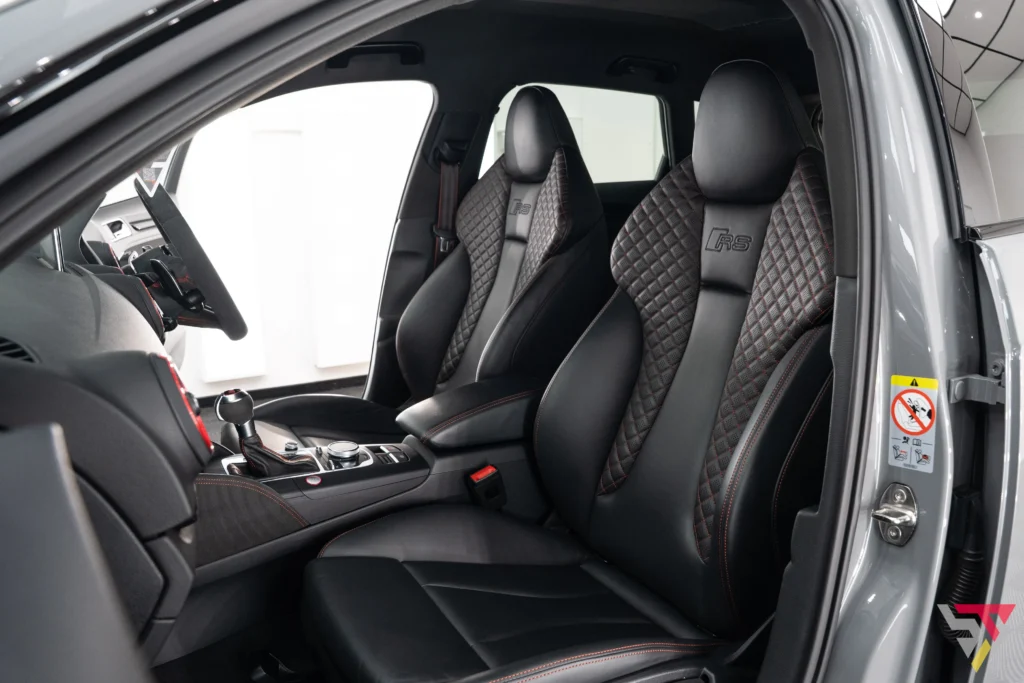

Extracting Its Full Potential: Tuning The RS3
Pre-Facelift 8V: The iron block engine is the strongest of the lot, so if seriously huge power is your goal, and you are prepared to shell out for the supporting mods required to make it, then the pre-facelift is hard to beat. However, for those just wanting to boost performance with some simple bolt-on mods, the potential is a little lower. A stage one ECU tune can bump output to around 410PS, while Stage 2, combined with a downpipe (with secondary cat delete), uprated intercooler, free flowing intake and a high flow fuel pump, will take it up to 430PS with a big slug more torque. Above Stage 2 the turbocharger runs out of puff and needs swapping to a hybrid turbo to extract more gains.
DAZA 8V.2: The lightweight aluminium DAZA engine may not be as strong as the iron-block, but the larger turbo and increased fuelling means power gains are much easier won. An MRC Tuning Stage 1 tune, combined with a Forge turbo elbow will unleash around 490PS. Stage 2 requires the elbow, plus a front mount intercooler and a downpipe with sports cats but can increase grunt to 530PS. Above this is stage 3 where things get serious. Joining the mods above would be a TT700 turbo, 980cc injectors, and additional supporting mods, but you can comfortably expect between 570-600bhp+
DWNA 8V.2: The OPF filters in the DWNA cars mean power is slightly restricted, with a Forge turbo elbow and Stage 1 remap only making 460PS. But add a downpipe with secondary cat delete and you’re looking nearer 490PS. Once you get past this point, the potential power output becomes very similar to DAZA cars when tuned.
8Y: The latest 8Y model’s engine is essentially the same as the DNWA cars, so responds very similar when tuned.
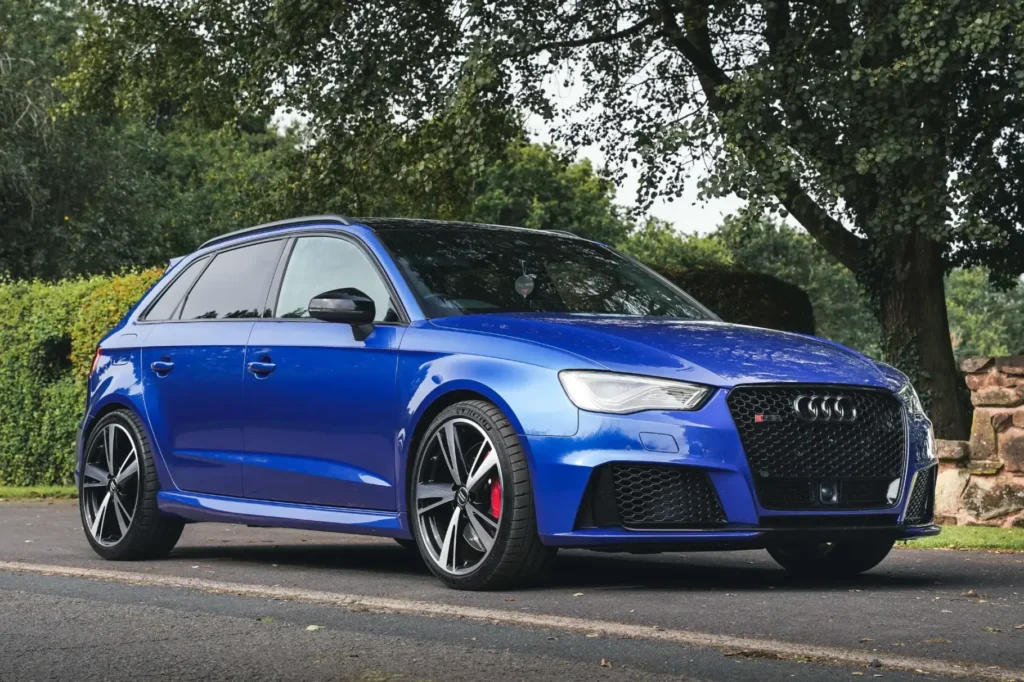
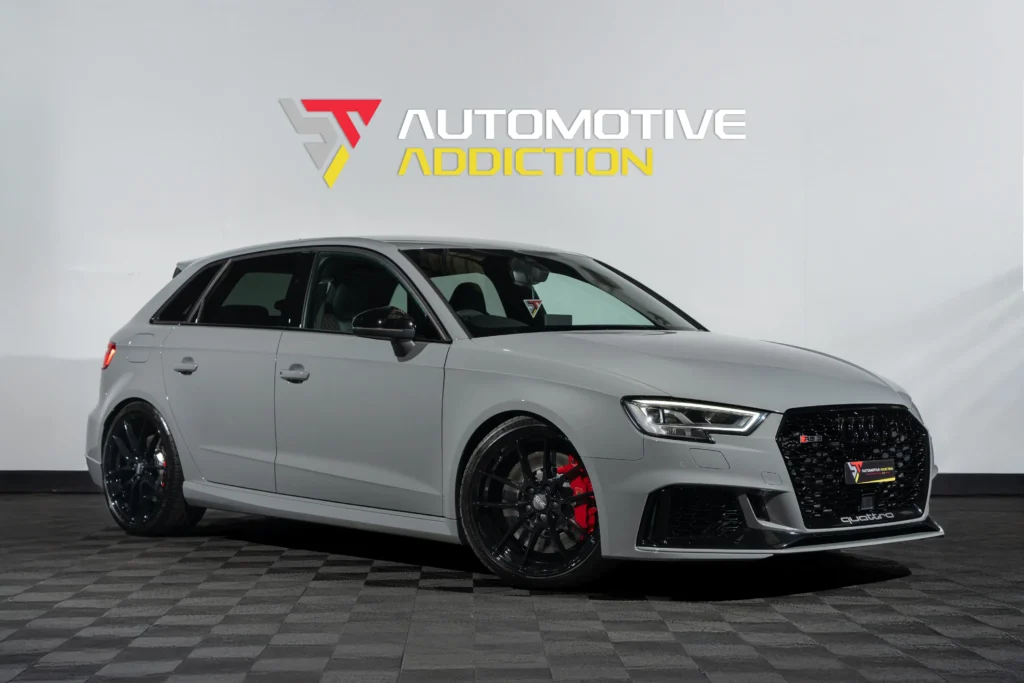
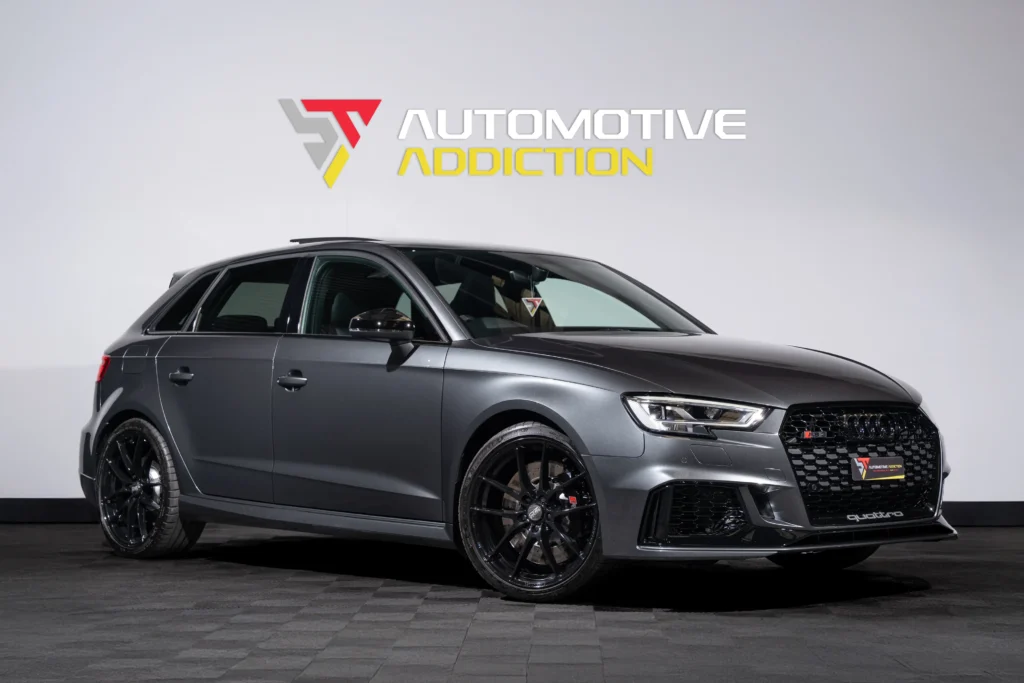
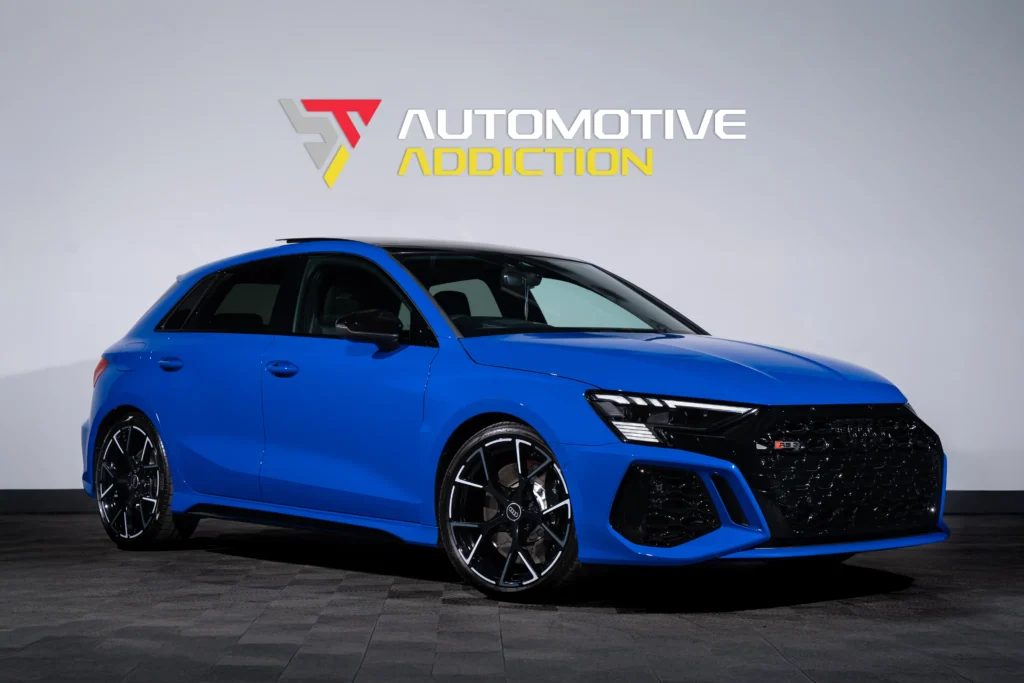
So, Which RS3 Should You Buy?
It depends on your priorities.
Best value entry point: The pre-facelift 8V. Affordable, still fast, but requires more maintenance and mods to shine.
Best base for tuning: The 8V.2 DAZA. Light, strong, charismatic, and hugely tunable. The one enthusiasts fight over.
Best balance of newness and subtlety: The OPF 8V.2. Same punch, quieter manners, newer build dates.
Best driver’s car: The 8Y. Its torque-splitter makes it a revelation on real roads and tracks, even if tuning requires a bigger budget.
Whichever you choose, the RS3 remains one of the most complete performance cars on sale—a supercar heart in a practical, everyday body. Few cars blend speed, usability, and heritage as well as this Audi.
Watch our Audi Buyers Guide: Factory Optional Extras
Find Your RS3 at Automotive Addiction
At Automotive Addiction, we specialise in sourcing, preparing, and presenting the very best examples of the Audi RS3 across all generations—including the highly sought-after DAZA 8V.2 and the latest 8Y models. Every car is handpicked, painstakingly inspected, fully detailed in our in-house studio, and presented to the highest standard.
If you’re ready to experience the furious five-cylinder performance that the RS3 is renowned for, browse our current stock here or call our team to discuss securing your car with a deposit. Your perfect hot hatch is waiting!

